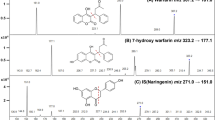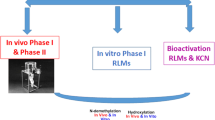Abstract
Berberine (BBR) is a natural alkaloid obtained from Berberis species plants, known for its protective effects against several diseases. Among the primary BBR metabolites, berberrubine (M1) showed the highest plasma concentration but few and conflicting data are available regarding its concentration in biological fluids related to its new potential activity on vascular cells. A combined analytical approach was applied to study biodistribution of M1 in comparison with BBR. The optimization of sample clean-up combined with a fully validated HPLC-ESI-MS/MS tailored for M1 allows sufficient detectability and accuracy to be reached in the different studied organs even when administered at low dose, comparable to that assumed by human. A predictive human vascular endothelial cell-based assay to measure intracellular xanthine oxidase has been developed and applied to study unexplored activities of M1 alongside other common activities. Results showed that oral M1 treatment exhibits higher plasma levels than BBR, reaching maximum concentration 400-fold higher than BBR (204 vs 0.5 ng/mL); moreover, M1 exhibits higher concentrations than BBR also in all the biological compartments analyzed. Noteworthy, the two compounds follow two different excretion routes: M1 through urine, while BBR through feces. In vitro studies demonstrated that M1 inhibited intracellular xanthine oxidase activity, one of the major sources of reactive oxygen species in vasculature, with an IC50 = 9.90 ± 0.01 μg/mL and reduced the expression of the inflammatory marker ICAM-1. These peculiar characteristics allow new perspectives to be opened up for the direct use of M1 instead of BBR in endothelial dysfunction treatment.




Similar content being viewed by others
References
Franco P, Spinozzi S, Pagnotta E, Lazzeri L, Ugolini L, Camborata C, et al. Development of a liquid chromatography–electrospray ionization–tandem mass spectrometry method for the simultaneous analysis of intact glucosinolates and isothiocyanates in Brassicaceae seeds and functional foods. J Chromatogr A. 2016;1428:154–61.
Marazzi G, Cacciotti L, Pelliccia F, Iaia L, Volterrani M, Caminiti G, et al. Long-term effects of nutraceuticals (berberine, red yeast rice, policosanol) in elderly hypercholesterolemic patients. Adv Ther. 2011;28:1105.
Amin AH, Subbaiah TV, Abbasi KM. Berberine sulfate: antimicrobial activity, bioassay, and mode of action. Can J Microbiol. 1969;15:1067–76.
Sabir M, Bhide NK. Study of some pharmacological actions of berberine. (1971). Indian J Physiol Pharmacol. 1971;15:111–32.
Qiu F, Zhu Z, Kang N, Piao S, Qin G, Yao X. Isolation and identification of urinary metabolites of berberine in rats and humans. Drug Metab Dispos. 2008;36:2159–216.
Li Y, Ren G, Wang YX, Kong WJ, Yang P, Wang YM, et al. Bioactivities of berberine metabolites after transformation through CYP450 isoenzymes. J Transl Med. 2011;9:62.
Wang X, Wang S, Ma J, Ye T, Lu M, Fan M, et al. Pharmacokinetics in rats and tissue distribution in mouse of berberrubine by UPLC-MS/MS. J Pharm Biomed Anal. 2015;115:368–74.
Yang N, Sun R, Zhao Y, He J, Zhen L, Guo J, et al. High fat diet aggravates the nephrotoxicity of berberrubine by influencing on its pharmacokinetic profile. Environ Toxicol Pharmacol. 2016;46:319–27.
Li F, Song S, Guo Y, Zhao Q, Zhang X, Pan W, et al. Preparation and pharmacokinetics evaluation of oral self-emulsifying system for poorly water-soluble drug Lornoxicam. Drug Deliv. 2015;22:487–98.
Pouton CW. Formulation of poorly water-soluble drugs for oral administration: physicochemical and physiological issues and the lipid formulation classification system. Eur J Pharm Sci. 2006;29:278–87.
Kulkarni SK, Dhir A. Berberine: a plant alkaloid with therapeutic potential for central nervous system disorders. Phytother Res. 2010;24:317–24.
El-Salam MA, Mekky H, El-Naggar EMB, Ghareeb D, El-Demellawy M, El-Fiky F. Hepatoprotective properties and biotransformation of berberine and berberrubine by cell suspension cultures of Dodonaea viscosa and Ocimum basilicum. S Afr J Bot. 2015;97:191–5.
Wang K, Feng X, Chai L, Cao S, Qiu F. The metabolism of berberine and its contribution to the pharmacological effects. Drug Metab Rev. 2017;49:1–19.
Zhou Y, Cao S, Wang Y, Xu P, Yan J, Bin W, et al. Berberine metabolites could induce low density lipoprotein receptor up-regulation to exert lipid-lowering effects in human hepatoma cells. Fitoterapia. 2014;92:230–7.
Chen HY, Ye XL, Cui XL, He K, Jin YN, Chen Z, et al. Cytotoxicity and antihyperglycemic effect of minor constituents from Rhizoma Coptis in HepG2 cells. Fitoterapia. 2012;83:67–73.
Yang N, Sun RB, Chen XL, Zhen L, Ge C, Zhao HJ, et al. In vitro assessment of the glucose-lowering effects of berberrubine-9-O-β-D-glucuronide, an active metabolite of berberrubine. Acta Pharmacol Sin. 2017;38:351.
Caliceti C, Rizzo P, Ferrari R, Fortini F, Aquila G, Leoncini E, et al. Novel role of the nutraceutical bioactive compound berberine in lectin-like OxLDL receptor 1-mediated endothelial dysfunction in comparison to lovastatin. Nutr Metab Cardiovasc Dis. 2017;27:552–63.
Caliceti C, Calabria D, Roda A. A new sensitive and quantitative chemiluminescent assay to monitor intracellular xanthine oxidase activity for rapid screening of inhibitors in living endothelial cells. Anal Bioanal Chem. 2016;408:8755–60.
Gui Q, Lawson T, Shan S, Yan L, Liu Y. The application of whole cell-based biosensors for use in environmental analysis and in medical diagnostics. Sensors. 2017;17:1623.
Rathbun CM, Prescher JA. Bioluminescent probes for imaging biology beyond the culture dish. Biochemistry. 2017;56:5178–84.
Spinozzi S, Colliva C, Camborata C, Roberti M, Ianni C, Neri F, et al. Berberine and its metabolites: relationship between physicochemical properties and plasma levels after administration to human subjects. J Nat Prod. 2014;77:766–72.
Guidance for industry. Q2B validation of analytical procedures. Methodology. 1996.
Kilkenny C, Browne W, Cuthill IC, Emerson M, Altman DG. Animal research: reporting in vivo experiments: the ARRIVE guidelines. J Gene Med. 2010;12:561–3.
Caliceti C, Aquila G, Pannella M, Morelli MB, Fortini C, Pinton P, et al. 17β-Estradiol enhances signalling mediated by VEGF-A-delta-like ligand 4-Notch1 axis in human endothelial cells. PLoS One. 2013;8:e71440.
Rizzo B, Zambonin L, Angeloni C, Leoncini E, Dalla Sega FV, Prata C, et al. Steviol glycosides modulate glucose transport in different cell types. Oxidative Med Cell Longev. 2013;2013:1–11.
Roda A, Russo C, Pasini P, Piazza F, Feroci G, Kricka LJ, et al. Antioxidant properties of bile salt micelles evaluated with different chemiluminescent assays: a possible physiological role. Luminescence. 1998;13:327–37.
Ma JY, Feng R, Tan XS, Ma C, Shou JW, Fu J, et al. Excretion of berberine and its metabolites in oral administration in rats. J Pharm Sci. 2013;102:4181–92.
Liu YT, Hao HP, Xie HG, Lai L, Wang Q, Liu CX, et al. Extensive intestinal first-pass elimination and predominant hepatic distribution of berberine explain its low plasma levels in rats. Drug Metab Dispos. 2010;38:1779–84.
Zuo F, Nakamura N, Akao T, Hattori M. Pharmacokinetics of berberine and its main metabolites in conventional and pseudo germ-free rats determined by liquid chromatography/ion trap mass spectrometry. Drug Metab Dispos. 2006;34:2064–72.
Caliceti C, Franco P, Spinozzi S, Roda A, Cicero AF. Berberine: new insights from pharmacological aspects to clinical evidences in the management of metabolic disorders. Curr Med Chem. 2016;23:1460–76.
Wang K, Qiao M, Chai L, Cao S, Feng X, Ding L, Qiu F. Identification of berberrubine metabolites in rats by using ultra-high performance liquid chromatography coupled with quadrupole time-of-flight mass spectrometry. Fitoterapia. 2017; article in press.
Wang K, Chai L, Feng X, Liu Z, Liu H, Ding L, et al. Metabolites identification of berberine in rats using ultra-high performance liquid chromatography/quadrupole time-of-flight mass spectrometry. J Pharm Biomed Anal. 2017;139:73–86.
Wang Y, Huang Y, Lam KS, Li Y, Wong WT, Ye H, et al. Berberine prevents hyperglycemia-induced endothelial injury and enhances vasodilatation via adenosine monophosphate-activated protein kinase and endothelial nitric oxide synthase. Cardiovasc Res. 2009;82:484–92.
Liu SJ, Yin CX, Ding MC, Wang YZ, Wang H. Berberine inhibits tumor necrosis factor-alpha-induced expression of inflammatory molecules and activation of nuclear factor-kappaB via the activation of AMPK in vascular endothelial cells. Mol Med Rep. 2015;12:5580–6.
Caliceti C, Calabria D, Roda A, Cicero AF. Fructose intake, serum uric acid, and cardiometabolic disorders: a critical review. Nutrients. 2017;9:395.
Dunn S, Vohra RS, Murphy JE, Homer-Vanniasinkam S, Walker JH, Ponnambalam S. The lectin-like oxidized low-density-lipoprotein receptor: a pro-inflammatory factor in vascular disease. Biochem J. 2008;409:349–55.
Commission Regulation (EU) 2017/1203 of 5th July 2017.
Author information
Authors and Affiliations
Corresponding author
Ethics declarations
All experiments were carried out according to the guidelines set forth by EEC Directive 86/609 on care and use of experimental animals. The protocol was approved by the Institutional Ethics Committee of the University of Bologna (Protocol 398/2016). All studies involving animals are reported in accordance with the ARRIVE guidelines.
Conflict of interest
The authors declare that they have no competing interest.
Additional information
Published in the topical collection Discovery of Bioactive Compounds with guest editors Aldo Laganà, Anna Laura Capriotti and Chiara Cavaliere.
Electronic supplementary material
ESM 1
(PDF 202 kb)
Rights and permissions
About this article
Cite this article
Porru, E., Franco, P., Calabria, D. et al. Combined analytical approaches to define biodistribution and biological activity of semi-synthetic berberrubine, the active metabolite of natural berberine. Anal Bioanal Chem 410, 3533–3545 (2018). https://doi.org/10.1007/s00216-018-0884-2
Received:
Revised:
Accepted:
Published:
Issue Date:
DOI: https://doi.org/10.1007/s00216-018-0884-2




